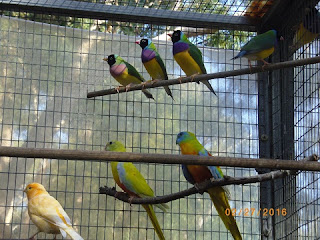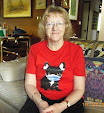The year is flying by. We made some much needed improvements to the aviaries just in time for winter, when the birds need shelter from the rain and cold weather here in Melbourne. Our aviaries were well constructed in the first place, but the metal roof only extended half way across, leaving the front section open to the weather, which we thought was a good idea at the time, giving the birds access to rain and sunshine. The disadvantages are that outside birds such as noisy miners, crows, butcher birds, etc. land on the wire section of the roof, leave their droppings, and scare the birds inside the aviary. Also, when it rains, the front section of the aviary became a quagmire, messy and smelly. The man who built our chook house came back and paved the back section of the aviaries, and put a fibreglass roof over the whole bank of aviaries, covering them from front to back, with an overhang at each end. So they are now doubly insulated against the weather, and the floor stays dry. We wish we'd been able to afford to do this right from the start!
We have lost several birds this year. Young Gouldian finches often die when it is extremely cold, and they have left the nest too young. The Turquoisine female died of unknown causes, one Scarlet Chested male escaped (flew out past me when I was half way out of it's aviary) and the pair of Princess Parrots both got out when Ken left the door unlocked when he came inside to take a phone call. I went back out an hour later and saw the door slightly ajar. Found the three Cockatiels sitting on the perch at the back of the aviary, gazing at me as if to say "aren't you lucky that we stayed inside"!
Ken has been busy this year, buying, selling and swapping birds with his friends at the Avicultural Society, some of whom live only ten minutes away by car. As they breed mostly the same birds, they swap male for female as they need, as well as different coloured birds in a species. Last week Ken acquired three more Turquoisine parrots - one pair, and one female to replace one that died. He swapped some of his Scarlet Chested young parrots for the Turks, so that saved both men quite a lot of money :)
Saturday, August 27, 2016
Tuesday, March 1, 2016
February 2016 Update.
I must make more of an effort to keep this blog up to date. So many things happen in aviaries in the course of the year, it is easy to miss hatches and matches while life goes on around you.
Our pair of young Scarlet Chested Parrots have been wonderful parents. They reared five young birds in their first clutch - 3 males and 2 females. Then she went down again, and hatched four more, so we have seven young Scarlets as well as their parents. Ken will eventually sell some of these at the Avicultural Society, to make room in the aviaries for this year's young ones as it looks like she will be a prolific layer.
Ken sold 15 canaries and 20 quail late last year, which has taken the pressure off the other birds. We could hardly walk inside the aviaries without nearly treading on quail, after they had gone mad and kept laying and hatching babies! They are so cute and we enjoyed seeing them, but once they grow up, they are like mice and keep breeding. So he has another 30 to sell, and will just keep one male and two females in each aviary for now. They will breed too, but this time he plans to control them by removing eggs once the female is sitting on half a dozen.
The canaries also had a breeding frenzy last year, so it was good to get rid of the majority of them, as while they can be kept with the Gouldian Finches, the canaries can be aggressive, and are always the first to get to the food when we put fruit and veg. in the avaries. While the Gouldians don't starve, we don't like seeing them pushed out of the way by the slightly bigger canaries!
Last week Ken succumbed to temptation and bought a pair of Turquoisines from a member of the Society at the meeting. K. had brought them along to the meeting to see if anyone would be interested, and Ken was very much interested, but hesitated, as he worries about overcrowding his birds. When I came over to have a look I said straight away "'Oh, you must buy them, they are beautiful!" So he did.
Fortunately the Neophema family of parrots are very docile, and live happily with the finches in the same aviaries.
Our pair of young Scarlet Chested Parrots have been wonderful parents. They reared five young birds in their first clutch - 3 males and 2 females. Then she went down again, and hatched four more, so we have seven young Scarlets as well as their parents. Ken will eventually sell some of these at the Avicultural Society, to make room in the aviaries for this year's young ones as it looks like she will be a prolific layer.
Ken sold 15 canaries and 20 quail late last year, which has taken the pressure off the other birds. We could hardly walk inside the aviaries without nearly treading on quail, after they had gone mad and kept laying and hatching babies! They are so cute and we enjoyed seeing them, but once they grow up, they are like mice and keep breeding. So he has another 30 to sell, and will just keep one male and two females in each aviary for now. They will breed too, but this time he plans to control them by removing eggs once the female is sitting on half a dozen.
The canaries also had a breeding frenzy last year, so it was good to get rid of the majority of them, as while they can be kept with the Gouldian Finches, the canaries can be aggressive, and are always the first to get to the food when we put fruit and veg. in the avaries. While the Gouldians don't starve, we don't like seeing them pushed out of the way by the slightly bigger canaries!
Last week Ken succumbed to temptation and bought a pair of Turquoisines from a member of the Society at the meeting. K. had brought them along to the meeting to see if anyone would be interested, and Ken was very much interested, but hesitated, as he worries about overcrowding his birds. When I came over to have a look I said straight away "'Oh, you must buy them, they are beautiful!" So he did.
Fortunately the Neophema family of parrots are very docile, and live happily with the finches in the same aviaries.
Saturday, October 31, 2015
Scarlet Chested parrot chicks have fledged!
It is just five weeks since the Scarlet Chested parrot babies hatched out, and today they all fledged the nest. Ken was in the process of putting rings on their legs, and he got the first one out of the nest box to do, and before he knew what was happening, he was surrounded by little flying missiles as they all jumped out of the nest box one after the other! Their last night in the nest box before they fledged:
Dad calling them up to the hole to feed them.
Mum had more success, the baby peeps out to be fed.
Ken holding two of the babies, showing the colours on the wings.
Dad calling them up to the hole to feed them.
Mum had more success, the baby peeps out to be fed.
Ken holding two of the babies, showing the colours on the wings.
Saturday, October 24, 2015
Friday, October 16, 2015
Scarlet Chested Parrots.
Ken bought a pair of Scarlets about six months ago, and it didn't take long for them to bond. He put the appropriate nesting box into their aviary, and they have been busy in the past month, laying eggs and hatching them. They have five healthy babies, and we are delighted!
The male is brightly coloured.
The female slightly less so, without the scarlet chest, but still beautiful.
One week old:
Two weeks old:
The male is brightly coloured.
The female slightly less so, without the scarlet chest, but still beautiful.
One week old:
Two weeks old:
Tuesday, August 25, 2015
Eastern Rosellas visiting our back yard.
There have always been Eastern Rosellas in the trees around our area, but they are very flighty, and don't often come down to the feeders on our front verandah. But when we had our front yard landscaped recently, we took an old feeding station down and put it in the back yard. We hadn't got around to putting it on a pole, so Ken simply parked the 'house' in the branches of a leafy tree outside the kitchen window. A pair of King Parrots were the first to discover it, and have been visiting most days since we started putting seed out.
The Galahs and Corellas have also noticed it, but they seem to prefer the front verandah, which suits us, as we like to see the Rosellas and King Parrots, and they won't come down if the bigger cockatoos are on the feeder. The Rainbow Lorikeets alternate between the back yard and front yard!
Here are the Eastern Rosellas - lots of photos because I just couldn't stop at one picture of these beautiful birds. The bird house had fallen from the tree one day, so we parked it on top of the compost bin, but the Rosellas didn't seem to mind!
The Galahs and Corellas have also noticed it, but they seem to prefer the front verandah, which suits us, as we like to see the Rosellas and King Parrots, and they won't come down if the bigger cockatoos are on the feeder. The Rainbow Lorikeets alternate between the back yard and front yard!
Here are the Eastern Rosellas - lots of photos because I just couldn't stop at one picture of these beautiful birds. The bird house had fallen from the tree one day, so we parked it on top of the compost bin, but the Rosellas didn't seem to mind!
Happy productive chooks.
The chooks have all settled in well and now they have all matured and gone through a moult, they are laying eggs regularly. One nest box clearly wasn't enough, so we called on Greg from Yummy Gardens to add another nest box to the coop. This was so successful that within half an hour of me putting hay in the new nest box, two eggs were laid in there!
Subscribe to:
Comments (Atom)



































